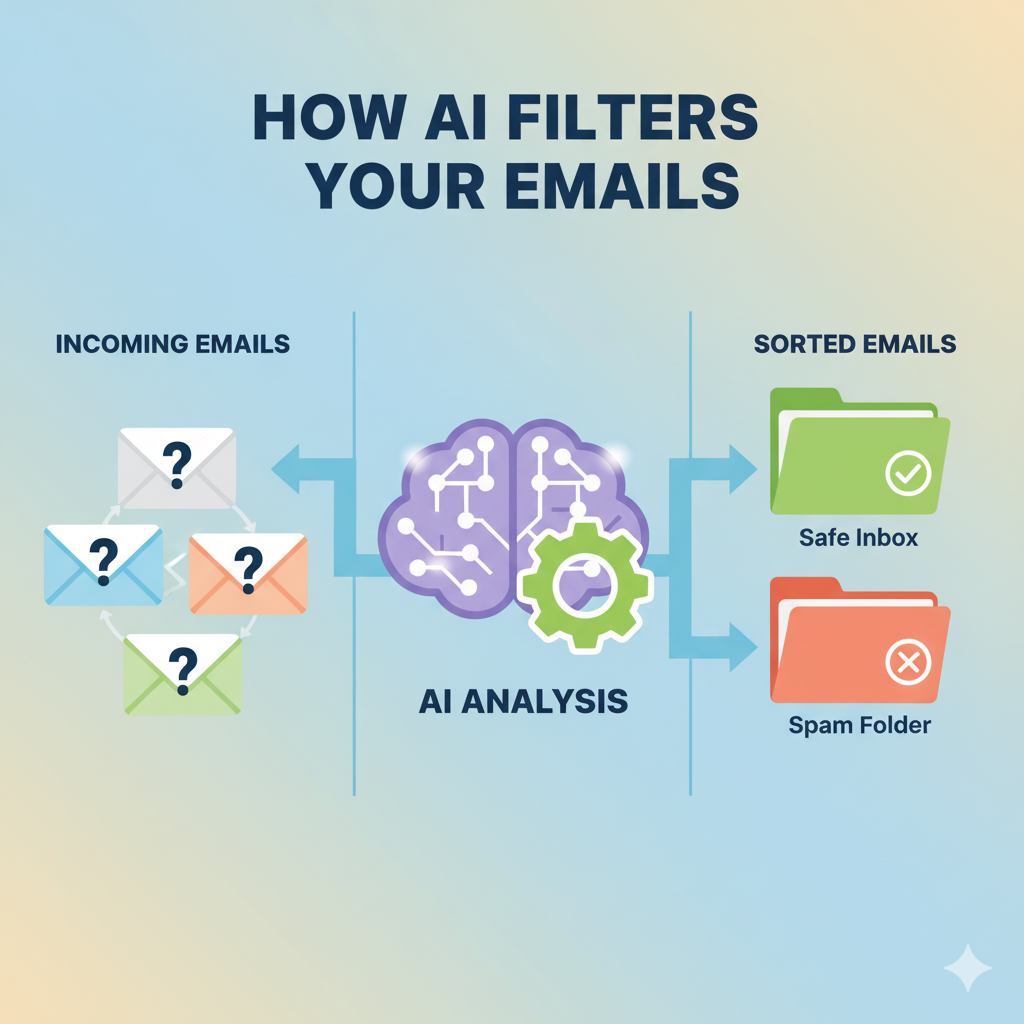Staying safe online is important for everyone, especially for seniors who are increasingly targeted by scammers. The good news is that Artificial Intelligence (AI) can be your powerful ally in detecting scam emails and protecting yourself from online fraud. This guide will show you how to use AI as your digital security guard in simple, step-by-step instructions.
What is AI and How Can It Protect You?
Think of AI as a smart assistant that has read millions of emails – both real ones and scams. It has learned to recognize the sneaky tricks and patterns that scammers use. This intelligent helper works 24/7 inside your email program to protect you, even while you sleep.
How Your Email’s Built-In AI Already Protects You
- The Spam/Junk Folder: That folder where suspicious emails go? An AI program put them there after analyzing the sender, words, and links.
- Color-Coded Warnings: Bright yellow or red banners that say “This sender is not trusted” are your AI assistant warning you to be careful.
- The Silent Shield: AI stops over 99% of dangerous emails before you ever see them – like having a security guard for your digital mailbox.

How to Team Up with AI: A Step-by-Step Guide
Step 1: Trust the AI Warnings
If your email service puts a message in “Spam” or shows a warning banner, take it seriously. The AI is almost always correct. Never ignore these warnings.
Step 2: Learn the Red Flags AI Spots
AI is trained to recognize these common scam tactics. You can learn them too:
- Urgent Demands: “Your account will be closed in 24 hours!” Scammers want to panic you so you don’t think clearly.
- Generic Greetings: “Dear Valued Customer” instead of using your real name.
- Strange Email Addresses: Hover your mouse over the sender’s name. Does the actual email look odd? (Like “service@netflix-support.com” instead of “@netflix.com”)
- Requests for Personal Info: Your real bank or government agency will never ask for passwords or Social Security numbers via email.
- Poor Grammar and Spelling: Many scam emails contain obvious mistakes.
Step 3: Use Free AI Tools for a Second Opinion
If you’re still unsure about an email, ask another AI for help! Tools like Google Gemini or ChatGPT are like having a super-smart librarian you can consult for free.
Pro Tip: Don’t copy and paste the whole email (it might contain private info). Instead, describe the email like this:
“Can you check if this sounds like a scam? I got an email saying it’s from Microsoft Support. It says my computer has a virus and I need to call a 1-800 number immediately. The greeting was ‘Dear User.'”
Your Simple AI Safety Checklist
- ✅ If an email seems suspicious, don’t click any links or open attachments
- ✅ Trust your Spam folder and warning banners
- ✅ When in doubt, delete the email immediately
- ✅ For a second opinion, describe the email to a free AI tool
- ✅ If it’s about an account, log in directly through the official website – never use the link in the email

Frequently Asked Questions (FAQ)
Is AI difficult for seniors to use for email security?
Not at all! The most powerful AI protection works automatically in the background of your email service. You don’t need to do anything special – just pay attention to the warnings it provides.
What should I do if I accidentally clicked a link in a scam email?
Immediately run a virus scan on your computer, change your passwords (starting with your email password), and monitor your bank accounts for unusual activity. Consider contacting your bank to alert them of potential fraud.
Are free AI tools like ChatGPT safe for checking scam emails?
Yes, when used properly. Never paste personal information, passwords, or full email headers. Instead, describe the email in general terms as shown in our examples.
How can I tell the difference between a real security alert and a scam?
Legitimate companies will never ask for your password or full Social Security number via email. When in doubt, contact the company directly using a phone number or website you know is genuine – not the contact information in the suspicious email.
What’s the most common mistake seniors make with scam emails?
The most common mistake is letting urgency override caution. Scammers create false emergencies to make you act without thinking. Always take a moment to verify before clicking links or sharing information.
Final Thoughts
By understanding that a helpful AI is already working to protect you, and by learning the simple red flags, you can browse your inbox with much more confidence. Technology can be both a source of risk and your best protection. With AI as your digital companion, you’re taking a powerful step toward safer online experiences.
Remember: When it comes to email safety, if something feels wrong, it probably is. Trust your instincts and let AI be your second pair of eyes.


